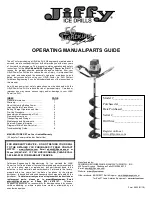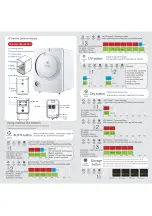
44
ConMet
8. Brake and Wheel Installation (continued)
Do not get lubricant on the mounting face of
the drum or wheel. Failure to clean lubricant
from these surfaces may result in decreased
clamping load.
CAUTION
!
4. Before installation of brake
drums and wheels that utilize
the hub piloted system, rotate
the hub so one of the wheel
pilot bosses is at the top (12
o’clock position) (see figure 92).
34
105758a
WHEEL PILOT BOSS
Rotating the Hub
FIGURE 92
5. Position the brake drum over
the hub, so it seats on the drum
pilot and against the hub face.
6. Place the wheel(s) into position.
One or more nuts can be
started in order to hold wheel(s)
and drum into position.
7. Snug the top nut first. Apply 50
ft-lbs torque to draw the brake
drum up fully against the hub
(see figure 93).
35
106824b
Reinstalling the Wheel
FIGURE 93
8. Install the remaining wheel nuts
and using the sequence as
shown, torque all the nuts to 50
ft-lbs, then retorque to 450-500
ft-lbs (see figure 89 and figure
90). The last nut rotation must
be with a calibrated torquing
device.
When torquing wheel nuts, the temperature
of all the wheel end components should be as
close as possible to the midpoint of the expected
operating range. For example, if the hub will
operate between 0°F and 150°F, 75°F is a good
temperature to torque at. Room temperature
is often a close approximation of the midpoint
temperature.
This recommendation is due to the differences
in the coefficient of thermal expansion for the
various materials in the wheel end including the
hub, studs, wheel and brake drum. If the wheel
nuts are torqued at temperatures well below the
midpoint, when the system warms up, the studs
may become overstressed. This could cause the
studs to be permanently stretched, leading to
nut loosening or damage to the wheel or hub. If
the torque is applied at elevated temperatures,
the system may become loose and lose clamp at
lower temperatures, resulting in wheel damage
and broken wheel studs. If the nuts must be
torqued at extreme temperatures, the nut torque
should be readjusted when the temperature is in
the desired range. See also TMC RP250 "Effects
of Extreme Temperatures on Wheel Torque and
Clamp Load".
NOTE
Use the appropriate nuts with the above
technique to install the front and outer dual
wheels. Follow your shop practice to locate the
valve stems.
NOTE
9. Inspect the brake and wheel
installation by checking the
seating of the wheel(s) and
drum at the pilots, and by
turning the wheel(s) and
checking for any irregularity.
Excessive or inadequate wheel nut torque can
cause a failure of the wheel mounting system and
a wheel separation resulting in severe personal
injury or death and property damage. Always use
a device that measures the torque being applied.
After the first 50-100 miles, retorque all the
nuts to 450-500 ft-lbs. Loosen the outer nuts to
retorque the inner nuts.
DANGER
!
Ball Seat Wheel Mounting System
1. Clean all mating surfaces on the
hub, drum, wheels and nuts.
Remove loose paint, scale, and
any material building around
the pilots of the drum, hub, and
wheels. Be sure paint is fully
cured on recently refurbished
wheels.
When dual wheels are mounted, the stud length
beyond the brake drum (standout) should be from
1.31-1.44" as measured from the brake drum to
the end of the stud (see figure 94).
When mounting dual aluminum wheels, use
ALCOA inner cap nuts 5978R and 5978L or the
equivalent. These nuts can also be used with
longer studs up to 1.88" standout.
For special single aluminum wheel applications
on drive and trailer hubs, use ALCOA single cap
nuts 5995R and 5995L, or 5554R and 5554L or the
equivalent, depending on the stud thread length
(see Table A).
For single steel wheel applications, use BATCO
13-3013R and 13-3013L or the equivalent (see
TableB).
NOTE
36
1
2
3
4
5
106812a
HUB
BRAKE
DRUM
Stud Standout
FIGURE 94
















































